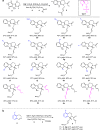Development of bifunctional organocatalysts and application to asymmetric total synthesis of naucleofficine I and II
- PMID: 31358765
- PMCID: PMC6662887
- DOI: 10.1038/s41467-019-11382-8
Development of bifunctional organocatalysts and application to asymmetric total synthesis of naucleofficine I and II
Abstract
The proline-type organocatalysts has been efficiently employed to catalyze a wide range of asymmetric transformations; however, there are still many synthetically useful and challenging transformations that remain unachievable in an asymmetric fashion. Herein, a chiral bifunctional organocatalyst with a spirocyclic pyrrolidine backbone-derived containing fluoro-alkyl and aryl sulfonamide functionalities, are designed, prepared, and examined in the asymmetric Mannich/acylation/Wittig reaction sequence of 3,4-dihydro-β-carboline with acetaldehyde, acyl halides, and Wittig reagents. As a result, the spirocyclic pyrrolidine trifluoromethanesulfonamide catalyst can facilitate this versatile sequence as demonstrated by 18 examples displaying excellent enantioselectivity (up to 94% ee), as well as moderate to good yields (up to 54% over 3 steps). As a practical application, the asymmetric total synthesis of naucleofficine I (1a) and II (1b) in ten steps have been accomplished.
Conflict of interest statement
The authors declare no competing interests.
Figures





Similar articles
-
The synthesis of chiral β-naphthyl-β-sulfanyl ketones via enantioselective sulfa-Michael reaction in the presence of a bifunctional cinchona/sulfonamide organocatalyst.Beilstein J Org Chem. 2021 Feb 18;17:494-503. doi: 10.3762/bjoc.17.43. eCollection 2021. Beilstein J Org Chem. 2021. PMID: 33727972 Free PMC article.
-
Chiral N,N'-dioxides: new ligands and organocatalysts for catalytic asymmetric reactions.Acc Chem Res. 2011 Aug 16;44(8):574-87. doi: 10.1021/ar200015s. Epub 2011 Jun 24. Acc Chem Res. 2011. PMID: 21702458
-
4-Fluoro and 4-Hydroxy Pyrrolidine-thioxotetrahydropyrimidinones: Organocatalysts for Green Asymmetric Transformations in Brine.J Org Chem. 2015 Jun 5;80(11):5464-73. doi: 10.1021/acs.joc.5b00283. Epub 2015 May 11. J Org Chem. 2015. PMID: 25942500
-
Design of Bifunctional Amino Tf-Amide Organocatalysts and Application in Various Asymmetric Transformations.Chem Rec. 2022 May;22(5):e202200004. doi: 10.1002/tcr.202200004. Epub 2022 Feb 18. Chem Rec. 2022. PMID: 35179310 Review.
-
Catalytic asymmetric organozinc additions to carbonyl compounds.Chem Rev. 2001 Mar;101(3):757-824. doi: 10.1021/cr000411y. Chem Rev. 2001. PMID: 11712502 Review.
Cited by
-
Recent advances in catalytic asymmetric synthesis.Front Chem. 2024 May 9;12:1398397. doi: 10.3389/fchem.2024.1398397. eCollection 2024. Front Chem. 2024. PMID: 38783896 Free PMC article. Review.
-
Recent Advances in Asymmetric Synthesis of Pyrrolidine-Based Organocatalysts and Their Application: A 15-Year Update.Molecules. 2023 Feb 27;28(5):2234. doi: 10.3390/molecules28052234. Molecules. 2023. PMID: 36903480 Free PMC article. Review.
-
Direct Activation of Sulfides by C-H Oxidation with Photoexcited Nitroarenes: Formal Manipulations of the C─S Bond.Angew Chem Int Ed Engl. 2025 Aug 11;64(33):e202509244. doi: 10.1002/anie.202509244. Epub 2025 Jun 18. Angew Chem Int Ed Engl. 2025. PMID: 40481690 Free PMC article.
-
Cu(ii)/SPDO complex catalyzed asymmetric Baeyer-Villiger oxidation of 2-arylcyclobutanones and its application for the total synthesis of eupomatilones 5 and 6.Chem Sci. 2022 Jun 23;13(28):8429-8435. doi: 10.1039/d2sc02079c. eCollection 2022 Jul 20. Chem Sci. 2022. PMID: 35919715 Free PMC article.
-
Enantioselective, Catalytic Multicomponent Synthesis of Homoallylic Amines Enabled by Hydrogen-Bonding and Dispersive Interactions.J Am Chem Soc. 2021 May 19;143(19):7272-7278. doi: 10.1021/jacs.1c03024. Epub 2021 May 5. J Am Chem Soc. 2021. PMID: 33949857 Free PMC article.
References
Publication types
LinkOut - more resources
Full Text Sources
Molecular Biology Databases
Research Materials

